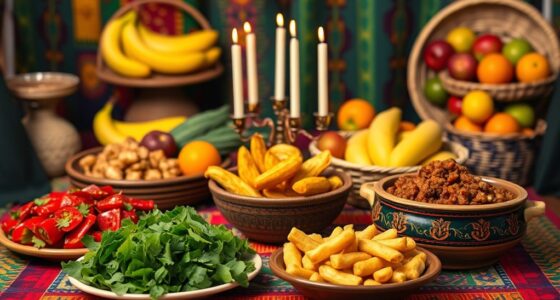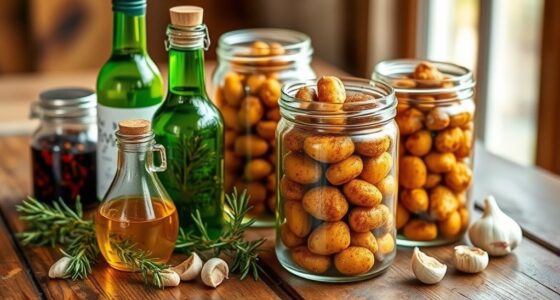Pumpkin pie spice has roots in a centuries-old global trade network that brought exotic spices from Asia, the Middle East, and Europe into everyday kitchens. These spices, like cinnamon, ginger, and nutmeg, transformed regional dishes into seasonal favorites, especially during fall. Over time, traders and explorers spread these flavors worldwide, blending native ingredients with imported spices. If you keep exploring, you’ll discover how centuries of trade and cultural exchange shaped this beloved holiday blend.
Key Takeaways
- Pumpkin pie spice evolved from regional spice blends influenced by global trade routes.
- Spices like cinnamon, ginger, and nutmeg have origins in Asian, Middle Eastern, and European trade networks.
- The spice trade facilitated cultural exchange, transforming local cuisines with imported aromatic ingredients.
- Commercialization in the 19th and 20th centuries made pumpkin pie spice widely accessible worldwide.
- Each pinch of pumpkin pie spice reflects centuries of exploration, trade, and interconnected culinary traditions.

Have you ever wondered where pumpkin pie spice comes from? It’s a blend that instantly evokes the cozy feeling of fall, but its roots run deep into seasonal flavor history and the vast web of the global spice trade. Originally, spices like cinnamon, ginger, nutmeg, and cloves were highly coveted commodities, traded across continents for centuries. These spices didn’t just add flavor—they carried stories of exploration, conquest, and cultural exchange. During the height of the global spice trade, traders from Asia, the Middle East, and Europe transported these fragrant treasures to distant lands, transforming local cuisines and creating new culinary traditions. Over time, these spices became staples in baked goods and desserts, especially in regions where seasonal flavors like pumpkin and squash became popular.
As European settlers and explorers encountered new ingredients and flavors through these trade routes, they began to combine local produce with imported spices, shaping what we now consider traditional fall flavors. Pumpkin pie spice is a prime example of this culinary evolution. Its creation wasn’t a single moment but a gradual process, influenced by available spices and regional preferences. When Europeans adopted pumpkin as a seasonal ingredient, they naturally paired it with the spices they knew well—cinnamon, ginger, and nutmeg—culinary staples brought back from their journeys through the spice trade. These spices, once exotic, became woven into the fabric of seasonal flavor history, especially in North America, where pumpkin pie became a holiday centerpiece.
The popularity of pumpkin pie spice grew alongside the rise of global trade networks. As trade expanded, so did the accessibility of these aromatic ingredients. By the 19th and 20th centuries, spice blends began appearing in households, and commercial versions of pumpkin pie spice emerged, simplifying the process for home bakers. Interestingly, the development of electric bikes and other modern transportation methods helped facilitate the global exchange of these ingredients, making exotic spices more widely available. The global spice trade played a pivotal role in shaping the flavors we now associate with seasonal traditions. Additionally, the history of trade routes highlights how interconnected our culinary practices truly are and how they have evolved through centuries of exchange. Every pinch of pumpkin pie spice carries the legacy of trade routes that connected distant parts of the world, bringing together flavors that now define a seasonal tradition. So, next time you sprinkle this warm spice mix into your pumpkin desserts, remember—you’re experiencing a centuries-old story of exploration, trade, and culinary innovation.
Frequently Asked Questions
How Did Pumpkin Pie Spice Become Popular Internationally?
You might wonder how pumpkin pie spice became popular internationally. It all started with spice blending and culinary innovation, as chefs and home cooks explored new flavors. As pumpkin pie gained popularity, so did its signature spice blend, which adds warmth and aroma. Through trade and globalization, this spice mixture traveled far beyond its origins, inspiring international recipes and making pumpkin pie spice a beloved ingredient worldwide.
What Are the Earliest Recorded Recipes Using Pumpkin Pie Spice?
They say “history repeats itself,” and with pumpkin pie spice, you can see that in its earliest recipes. Historical recipes from the 19th century show how cooks blended cinnamon, nutmeg, and ginger to create this fragrant mix. Spice blending was essential for flavor, and these recipes laid the foundation for the popular pumpkin pie spice we enjoy today. Your culinary journey begins with understanding these traditional, flavorful combinations.
Which Cultures Influenced the Development of Pumpkin Spice Blends?
You see, the development of pumpkin spice blends is a fascinating example of cultural fusion and spice synthesis. Different cultures, including Middle Eastern, Indian, and European, contributed unique spices like cinnamon, ginger, and cloves, shaping the blend we enjoy today. This blend reflects a rich history of trade and culinary exchange, where diverse traditions mixed to create a flavor that’s both familiar and globally inspired.
How Has Global Trade Affected Spice Availability Over Time?
You see, global trade has greatly increased spice availability over time. The spice trade, especially during colonial influence, opened new routes for exotic spices like cinnamon, nutmeg, and cloves. This made them more accessible and affordable worldwide. As a result, you can now enjoy diverse spice blends in recipes today. The historical trade routes shaped the flavors we love, connecting cultures and expanding culinary possibilities across the globe.
Are There Regional Variations in Pumpkin Pie Spice Recipes Worldwide?
Imagine pumpkin pie spice as a tapestry woven with seasonal spice variations and regional flavor preferences. You’ll find that recipes differ across the globe, reflecting local tastes and available ingredients. In North America, cinnamon dominates, while in the Middle East, cardamom and cloves might take center stage. These regional variations create a rich mosaic of flavors, showing how cultural influences shape even the simplest of seasonal treats.
Conclusion
So, now you see how pumpkin pie spice’s journey is more than just a simple blend—it’s a tapestry woven with history, culture, and trade. Understanding its roots shows that what we enjoy today is the result of many hands and stories across the globe. It’s a reminder that every spice has its own path, and sometimes, the best things in life come from the farthest corners. After all, it’s a small world after all.










